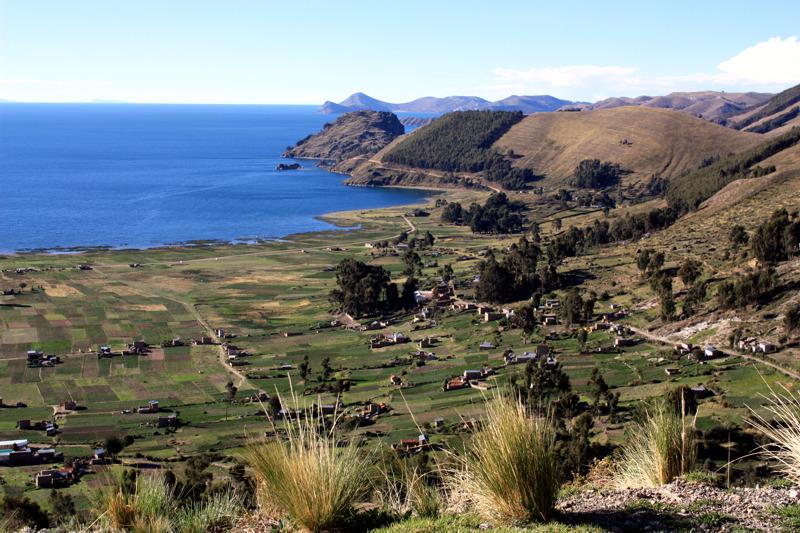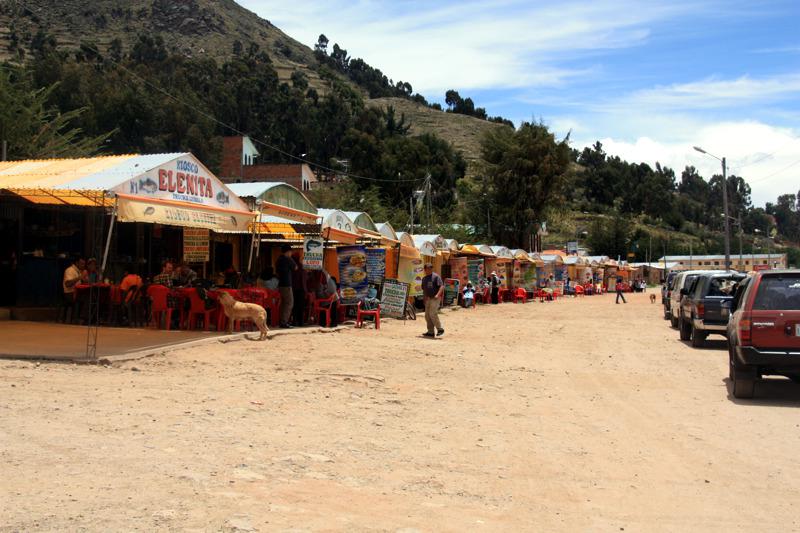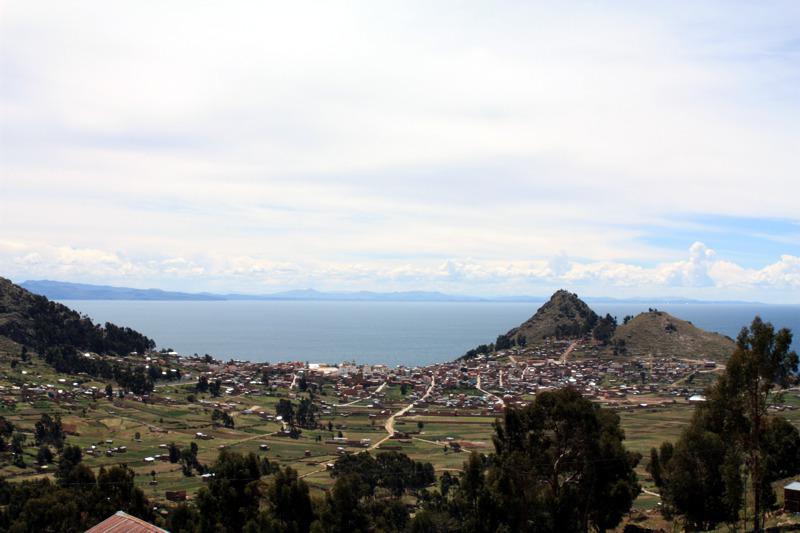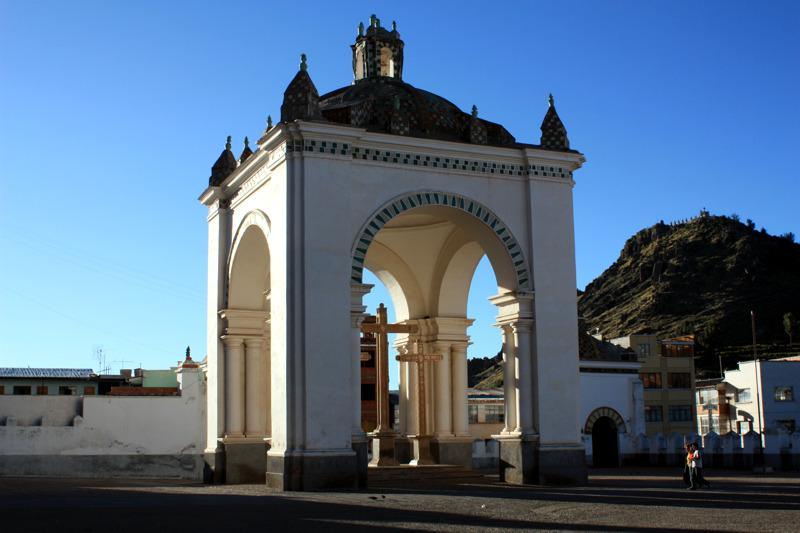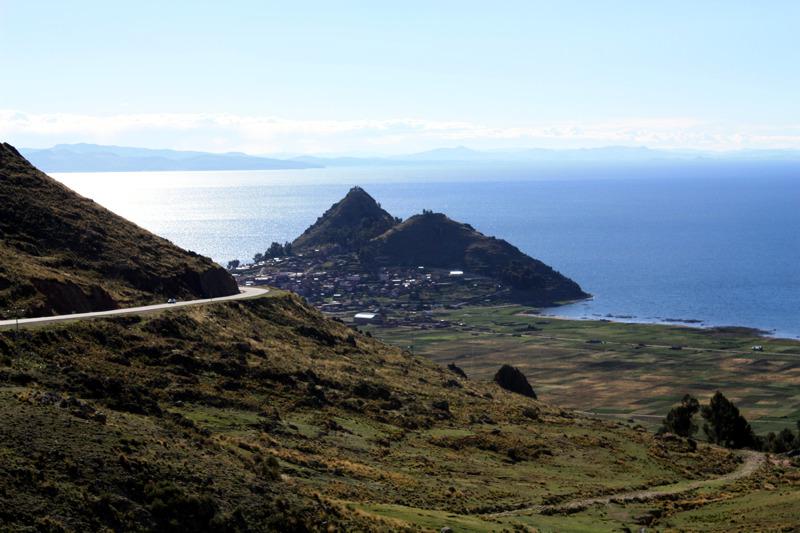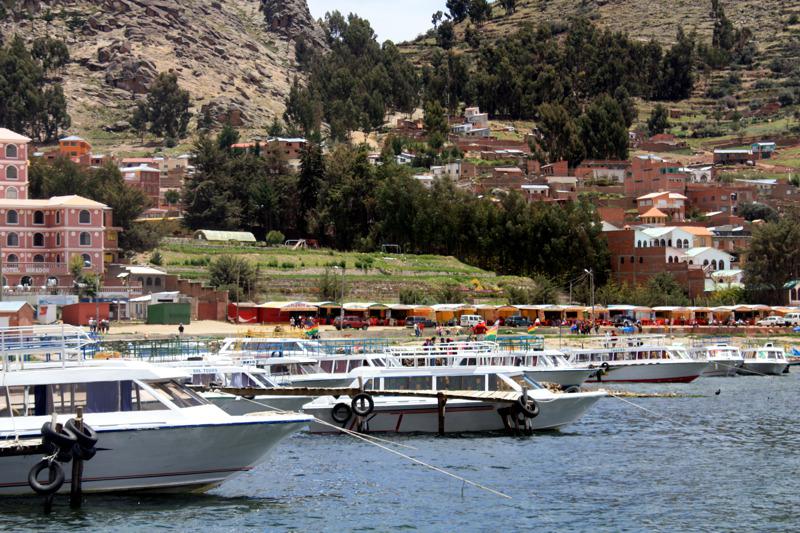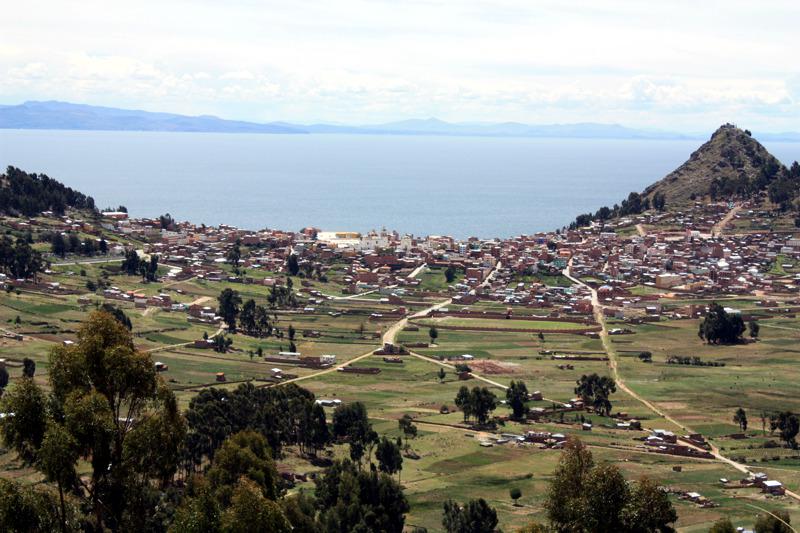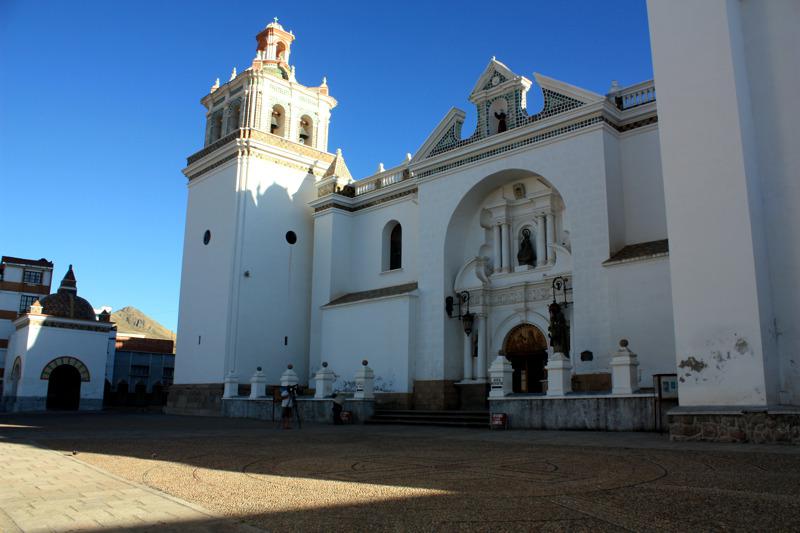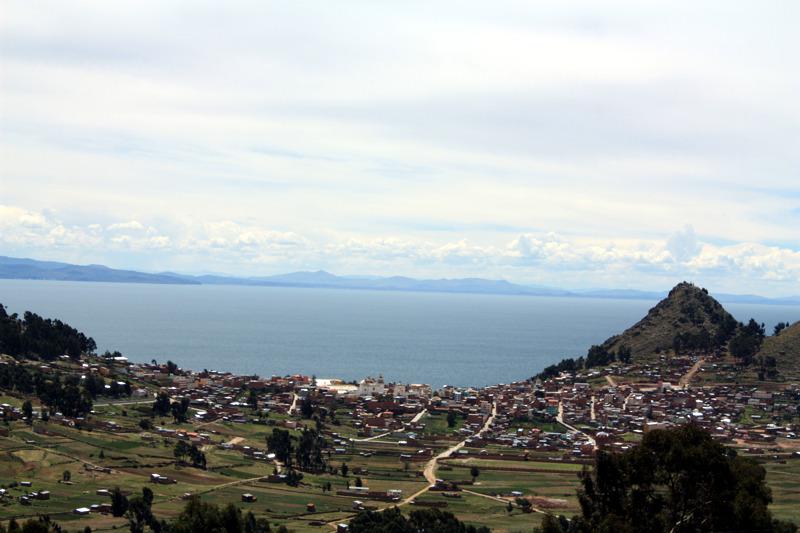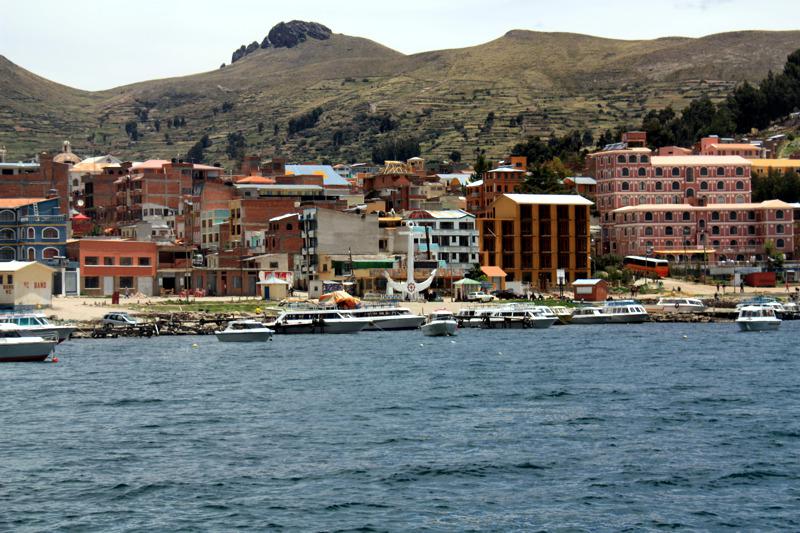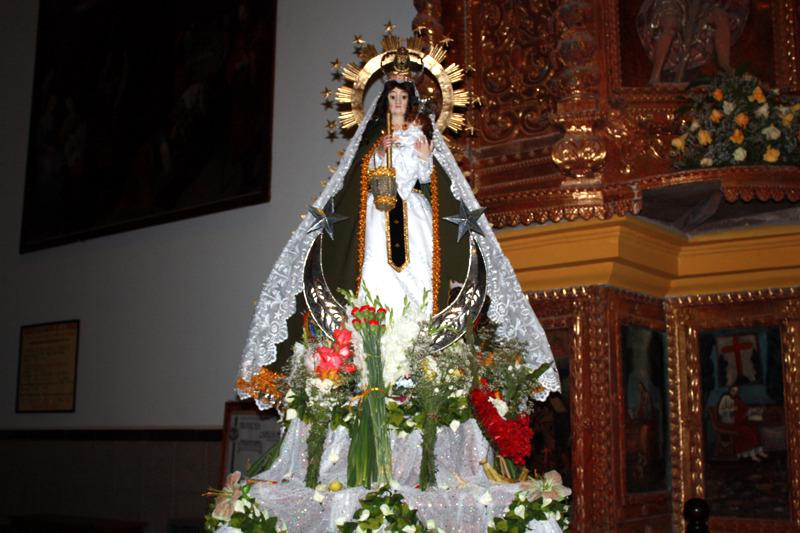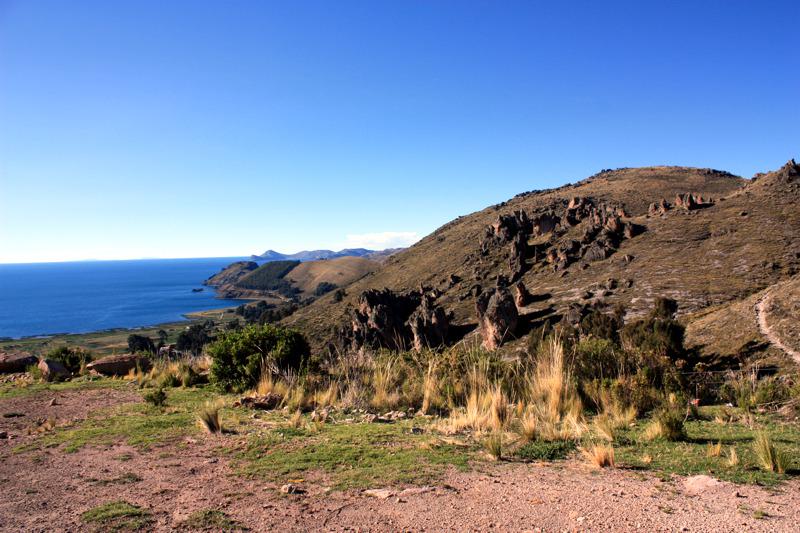Pictures of: Lake Titicaca, Bolivia
Location map
Airports
Hotels and other Accommodation
What to visit
Consulates & Embassies
World Nomads
The Travel Insurance with the largest coverage

The Travel Insurance with the largest coverage

Lake Titicaca
Lake Titicaca, with an area of 8300 km², is located in the Altiplano region, which is the largest area of the country, located between 3,100 meters and 4,500 meters above sea level, and includes in the western part of Bolivia beyond Lake Titicaca , La Paz, Oruro and the Salar de Uyuni.
It is the highest commercially navigable lake in the world and the second largest in Latin America, surpassed only by Lake Maracaibo in Venezuela.
Located on the Andes plateau, on the border of Peru and Bolivia, it has an average depth of 140 to 180 m, and a maximum depth of 280 m.
More than 25 rivers flow into Lake Titicaca, and the lake has 41 islands, some densely populated.
The origin of the name Titicaca is unknown; was translated as "Pedra do Puma", combining words from the local language Quíchua and Aimará. Locally, the lake is known under various names.
Titicaca is interesting for the population living in the Uros, nine artificial islands, some of them legendary - like the Island of the Sun, where the Incas believed to be the cradle of the Sun Father.
Lake Titicaca is fed by rainwater and the melting glaciers that surround the plateau.
It is the source of the Desaguadero River, which runs south through Bolivia to Lake Poopó; however, this tributary is responsible for less than five percent of the water loss, the remainder being due to evaporation due to intense winds and extreme exposure to sunlight at this altitude.
As the southeastern part of the lake is separated from the rest of the lake by the Tiquina Strait, the Bolivians call this small part of Lake Huinaymarca and the larger part of Lake Chucuito. In Peru, these small and large parts are known as Little Lake and Big Lake.
It is the highest commercially navigable lake in the world and the second largest in Latin America, surpassed only by Lake Maracaibo in Venezuela.
Located on the Andes plateau, on the border of Peru and Bolivia, it has an average depth of 140 to 180 m, and a maximum depth of 280 m.
More than 25 rivers flow into Lake Titicaca, and the lake has 41 islands, some densely populated.
The origin of the name Titicaca is unknown; was translated as "Pedra do Puma", combining words from the local language Quíchua and Aimará. Locally, the lake is known under various names.
Titicaca is interesting for the population living in the Uros, nine artificial islands, some of them legendary - like the Island of the Sun, where the Incas believed to be the cradle of the Sun Father.
Lake Titicaca is fed by rainwater and the melting glaciers that surround the plateau.
It is the source of the Desaguadero River, which runs south through Bolivia to Lake Poopó; however, this tributary is responsible for less than five percent of the water loss, the remainder being due to evaporation due to intense winds and extreme exposure to sunlight at this altitude.
As the southeastern part of the lake is separated from the rest of the lake by the Tiquina Strait, the Bolivians call this small part of Lake Huinaymarca and the larger part of Lake Chucuito. In Peru, these small and large parts are known as Little Lake and Big Lake.
Tourism
Bolivia and Peru share the sovereignty of Lake Titicaca which, in addition to being the highest navigable lake in the world, but also because of Andean mythology, because according to legend, Manco Capac and Mama Ocllo, children of the sun god and founders of the Inca Empire. In addition to a heady landscape, rich fauna inhabited in its waters and floating islands, Titicaca has interesting legends. The cradle of the Inca civilization reminds the traveler of the times when all Andean America was dominated by this people. A trip that tells the history of civilizations in unique and original settings.
The existing islands on Lake Titicaca have become a major tourist attraction in Bolivia. Another island, Taquile, is another major tourist attraction, featuring an indigenous community.
The inhabitants of Taquile are known for their handmade textile products, considered among the best quality in Peru.
On the Peruvian side there are several islands, among which the Amantaní, Taquile, Soto and Anapia, and the Uros, each with different attractions, stand out among them. As far as its vegetation is concerned, it grows at the edge of the lake, which serves as a refuge for various birds and fishes such as carachis, ispis, bogas, umantos, suches (endangered species), fishes and trout, all these species are native and quoted for their nutritional value.
The existing islands on Lake Titicaca have become a major tourist attraction in Bolivia. Another island, Taquile, is another major tourist attraction, featuring an indigenous community.
The inhabitants of Taquile are known for their handmade textile products, considered among the best quality in Peru.
On the Peruvian side there are several islands, among which the Amantaní, Taquile, Soto and Anapia, and the Uros, each with different attractions, stand out among them. As far as its vegetation is concerned, it grows at the edge of the lake, which serves as a refuge for various birds and fishes such as carachis, ispis, bogas, umantos, suches (endangered species), fishes and trout, all these species are native and quoted for their nutritional value.
Gastronomy
In rural Andean communities, food is essentially vegetable-based, predominantly tubers (potato, hollow and mashua), which are rich in carbohydrates, grain consumption (quinoa, amaranth and cañihua), rich in lysine and methionine and legumes (lupins, beans).
Recommended typical dishes are made from the base, trout, alpaca, meat, always accompanied by potatoes and vegetables, highly organic soup rich in calcium and quinoa.
Recommended typical dishes are made from the base, trout, alpaca, meat, always accompanied by potatoes and vegetables, highly organic soup rich in calcium and quinoa.
Weather
The climate of the region is cold semi-arid with cold winds, which blow all year round. Temperatures vary during the year between 15 ° C to 22 ° C during the day, while at night temperatures are often below zero.
The rainy season is during the months between November and March, while the winter months between April and October are dry, sunny and cold with bright and clear air. The capital La Paz for example has an annual rainfall between 500 mm and 600 mm. This area of the country can be visited all year round, but the best months are between April and October with clear sunny skies.
The rainy season is during the months between November and March, while the winter months between April and October are dry, sunny and cold with bright and clear air. The capital La Paz for example has an annual rainfall between 500 mm and 600 mm. This area of the country can be visited all year round, but the best months are between April and October with clear sunny skies.
Currency
The Bolivian
Official language
The main language spoken is Spanish, although Aymara and Quechua are also common. In addition, 34 other indigenous languages are official.
Documentation
Documents
Passport is required by all travelers except the following:
1. Travelers with national identity cards issued by Argentina, Bolivia, Brazil, Chile, Colombia, Ecuador, Paraguay, Peru and Uruguay.
2. Travelers with a "Diplomatic Pass" issued by the United Nations.
3. Travelers with documents issued to refugees and persons without nationality or citizenship.
Passports or alternative documents must be valid for at least 1 year, upon arrival.
Viewed
Issued by the Consulates of Bolivia (or consular section of the Embassies)
Application requirements:
One photo size of the passport.
Completed application form.
Passport valid for at least 1 year.
Fee payable in cash or check.
Return flight ticket and travel itinerary as proof of travel.
Certificate of vaccination against yellow fever may be required.
For Visas for Specific Stays, other than tourism, a letter of presentation from the relevant company or institution as proof of business intentions and the dates of travel.
Copy of confirmation of hotel reservations. If staying with friends or family, an invitation letter from the host in Bolivia can be used instead of hotel reservation. The letter should be addressed to the Embassy of Bolivia, and should indicate the relationship with the applicant, the dates of the visit, as well as the address and telephone number where you will be staying.
Time needed to issue visas
1 to 2 days for nationals requiring tourist visas without special authorization.
Approximately 6 weeks for all other citizens who require a tourist visa and special authorization from the Ministry of Foreign Affairs of Bolivia.
Visas must be required by everyone, provided they travel for tourist purposes, except:
From the countries mentioned above.
Nationals of Antigua and Barbuda, Argentina, Australia, Austria, Bahamas, Belgium, Brazil, Canada, Chile, Colombia, Costa Rica, Denmark, Ecuador, Finland, France, Germany, Greece, Iceland, Israel, Italy, Japan, Luxembourg, Monaco , New Zealand, Netherlands Antilles, Netherlands, Norway, Panama, Paraguay, Peru, Philippines, Poland, Portugal, Spain, Saint Lucia, Saint Kitts and Nevis, Saint Vincent and the Grenadines, South Africa, Sweden, Switzerland, Turkey, United Kingdom United Kingdom, United States of America, Uruguay, Vatican City;
Passengers in transit (except China nationals) who continue their journey on the same or first plane within 24 hours provided they have valid one-way or return documentation and do not leave the airport.
note:
All citizens traveling on business need a Specific Purpose Visa.
Nationals who do not require a tourist visa are generally allowed to stay for a period of 30-90 days, check with the Consulates of Bolivia (or consular section of the embassies).
In addition to a visa, citizens of many countries also need special authorization; check in the Consulates of Bolivia (or consular section of the Embassies).
Passport is required by all travelers except the following:
1. Travelers with national identity cards issued by Argentina, Bolivia, Brazil, Chile, Colombia, Ecuador, Paraguay, Peru and Uruguay.
2. Travelers with a "Diplomatic Pass" issued by the United Nations.
3. Travelers with documents issued to refugees and persons without nationality or citizenship.
Passports or alternative documents must be valid for at least 1 year, upon arrival.
Viewed
Issued by the Consulates of Bolivia (or consular section of the Embassies)
Application requirements:
One photo size of the passport.
Completed application form.
Passport valid for at least 1 year.
Fee payable in cash or check.
Return flight ticket and travel itinerary as proof of travel.
Certificate of vaccination against yellow fever may be required.
For Visas for Specific Stays, other than tourism, a letter of presentation from the relevant company or institution as proof of business intentions and the dates of travel.
Copy of confirmation of hotel reservations. If staying with friends or family, an invitation letter from the host in Bolivia can be used instead of hotel reservation. The letter should be addressed to the Embassy of Bolivia, and should indicate the relationship with the applicant, the dates of the visit, as well as the address and telephone number where you will be staying.
Time needed to issue visas
1 to 2 days for nationals requiring tourist visas without special authorization.
Approximately 6 weeks for all other citizens who require a tourist visa and special authorization from the Ministry of Foreign Affairs of Bolivia.
Visas must be required by everyone, provided they travel for tourist purposes, except:
From the countries mentioned above.
Nationals of Antigua and Barbuda, Argentina, Australia, Austria, Bahamas, Belgium, Brazil, Canada, Chile, Colombia, Costa Rica, Denmark, Ecuador, Finland, France, Germany, Greece, Iceland, Israel, Italy, Japan, Luxembourg, Monaco , New Zealand, Netherlands Antilles, Netherlands, Norway, Panama, Paraguay, Peru, Philippines, Poland, Portugal, Spain, Saint Lucia, Saint Kitts and Nevis, Saint Vincent and the Grenadines, South Africa, Sweden, Switzerland, Turkey, United Kingdom United Kingdom, United States of America, Uruguay, Vatican City;
Passengers in transit (except China nationals) who continue their journey on the same or first plane within 24 hours provided they have valid one-way or return documentation and do not leave the airport.
note:
All citizens traveling on business need a Specific Purpose Visa.
Nationals who do not require a tourist visa are generally allowed to stay for a period of 30-90 days, check with the Consulates of Bolivia (or consular section of the embassies).
In addition to a visa, citizens of many countries also need special authorization; check in the Consulates of Bolivia (or consular section of the Embassies).
Health care
In Bolivia the services of public hospitals are quite poor, while private hospitals have good facilities.
Before leaving, it is advisable to take health and travel insurance to cover any medical expenses.
No vaccine is required. Vaccination against yellow fever and malaria prophylaxis is recommended for those who intend to travel to the Amazon or the tropical zone to the east of the country.
Before leaving, it is advisable to take health and travel insurance to cover any medical expenses.
No vaccine is required. Vaccination against yellow fever and malaria prophylaxis is recommended for those who intend to travel to the Amazon or the tropical zone to the east of the country.
Communications and electricity
Mobile phones / Mobile phones: The mobile phone network does not cover the whole country. The technologies used in Bolivia are D-AMPS, GSM, GPRS, EDGE.
Mobile operators: Entel, Tigo, NuevaTel PCS.
Internet: Many hotels have free or paid Internet connections. Only in major cities are Internet cafes.
Electricity: The electric current is 115/230 volts, 50 Hz.
Electrical outlets: Electrical outlets in Bolivia are type A and type C. Outlets of type A are similar to those used in the United States of America, while type C outlets are the same as those in Europe.
Mobile operators: Entel, Tigo, NuevaTel PCS.
Internet: Many hotels have free or paid Internet connections. Only in major cities are Internet cafes.
Electricity: The electric current is 115/230 volts, 50 Hz.
Electrical outlets: Electrical outlets in Bolivia are type A and type C. Outlets of type A are similar to those used in the United States of America, while type C outlets are the same as those in Europe.
Other tourist destinations in:
Bolivia
Bolivia
Other world tourist destinations
Why to book with BOOK HOTEL MADEIRA
The best prices
Our partnerships with the world´s largest operators offer research on the best market prices.
More options
At Rotas Turisticos you can book the hotel, buy the air ticket, book the transfer from the airport to the hotel and vice versa, book the local excursions, rent the car, take travel insurance and consult the places to visit and where to go.
Holiday Tips & Destinations
Hundreds of holiday destinations with all the options that allow you to easily choose the destination that best suits your dream vacation.
BOOK HOTEL MADEIRA
Links


